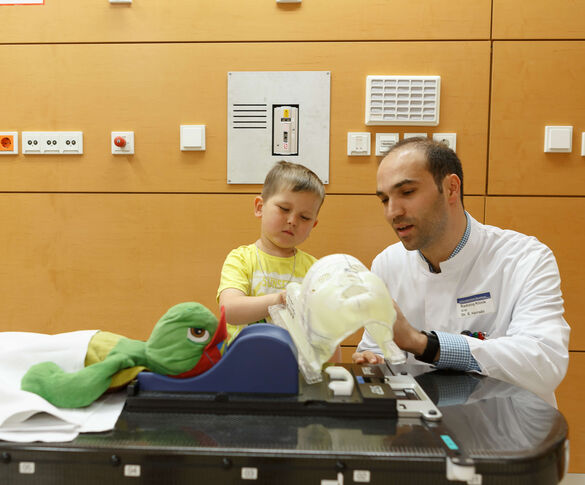Ion Beam Therapy: Gentle cancer therapy for children and adolescents
Interview with Dr. Semi Ben Harrabi
At the Heidelberg Ion Beam Therapy Center (HIT) for Children and Adolescents (so called KinderHIT), Dr. Harrabi is treating children and teenagers with certain tumor diseases together with specialists in pediatric oncology. Especially for the youngest, a gentle therapy with as little long-term consequences as possible is important. Dr. Semi Ben Harrabi explains why the Ion Beam Therapy is so special and why it is particularily suitable for the treatment of children and teenagers.

How many children are irradiated annually at KinderHIT?
As a large European centre, we treat around 80 to 100 patients at KinderHIT a year. However, the number of inquiries is much higher.
What is the advantage of radiation therapy with ion beams over X-rays in the treatment of tumors?
Ion beam radiation therapy has an extremely important characteristic compared to photon beams (X-rays): When the ion beam hits the patient, the very thin beam loses hardly any energy to the neighbouring tissue, since there is no scattered radiation. Instead, it releases its entire effective energy into the tumor tissue at the very end of its precisely calculated range. This area is called Bragg-Peak, because it is the point where radiation reaches its peak value. Once the beam passed the tumor, the dose drops to almost zero. That means that during ion beam therapy, the healthy neighbouring tissue before and behind the tumor is spared as optimal as never before – which is particularly important when sensitive organs such as the eyes, the spinal cord or the intestine are adjacent.
Furthermore, heavy ions are biologically more effective because they have a greater destructive effect than conventional photon radiation. Thus, a tumour cell irradiated with heavy ions is more likely to die because the genetic material of the cell is irreparably damaged. In contrast, with photon irradiation, the damage to genetic matieral is often less serious and may be repaired by the tumor cell.
Beyond that, heavy ions can destroy tumors that grow very slowly or that are poorly supplied with blood. In these cases, photons are often therapeutically not effective enough. In addition, higher doses can be administered with ion beams. Since they hit very precisely and healthy tissue is spared, the radiation dose can be increased in comparison to conventional photon irradiation by up to 20 percent with proton irradiation and by up to 35 percent with heavy ion irradiation. The higher the dose, the greater the probability that a patient can be cured.
Why is this particulary relevant in the treatment of children?
Cancer treatment in children and adolescents has a high chance of success. Thus, it is important to keep the risk of long-term side effects from therapy as slow as possible. Ion beam therapy makes it possible to reduce the radiation dose in healthy tissue considerably. Thus, among other things, growth and development deficits can be avoided and the risk of secondary tumors can be reduced.
For which pediatric tumors is treatment at HIT particularly suitable?
The use of proton irrradiation in children and adolescents should always be examined. However, it is particularly suitable for the treatment of brain tumors and (soft tissue) sarcomas in the skull base area.
The following indications are regularly treated at HIT:
- Ependymomas
- Medulloblastomas
- Gliomas
- Craniopharyngeomas
- Lymphomas
- Sarcomas
- Neuroblastomas
- Germ cell tumors
- Craniopharyngeomas
How do you ensure optimal treatment for young patients at HIT?
A close collaboration of different departments, such as paediatrics, anaesthesia, neurosurgery and, of course, radiooncology is very important to us. Together with our colleagues, we take sufficient time to discuss the optimal treatment and care of our little patients in the tumor board. The KinderHIT is financially supported by the Dietmar Hopp Foundation and is in direct neighbourhood to the Center for Child and Adolescent Medicine, as well as the National Center for Tumor Diseases (NCT) and soon the Hopp Child Tumor Center (KiTZ), which supports the interdisciplinary co-operation optimally and leads to short distances for families and relatives.
Does the treatment take place under anaesthesia?
The patient must lie very still during the radiation treatment. When treating very young children from five to six years of age, radiation without a sedative or anesthesia (no general anesthesia, only twilight sleep) is usually rarely possible. For reassurance, our young patients are also happy to bring a toy or a tablet PC with them.
How long does the therapy take?
A few minutes to a maximum of 30 minutes. The therapy usually lasts five to seven weeks and radiation is usually administered once a day five days a week.
What needs to be taken into account when treating children?
For our young patients, the treatment is an extraordinary experience. It is therefore important for us to give them a lot of attention, time and care. We want to make sure that the child and its parents feel comfortable with our team and can talk about their hopes and expectations of the therapy as well as their fears and worries.

